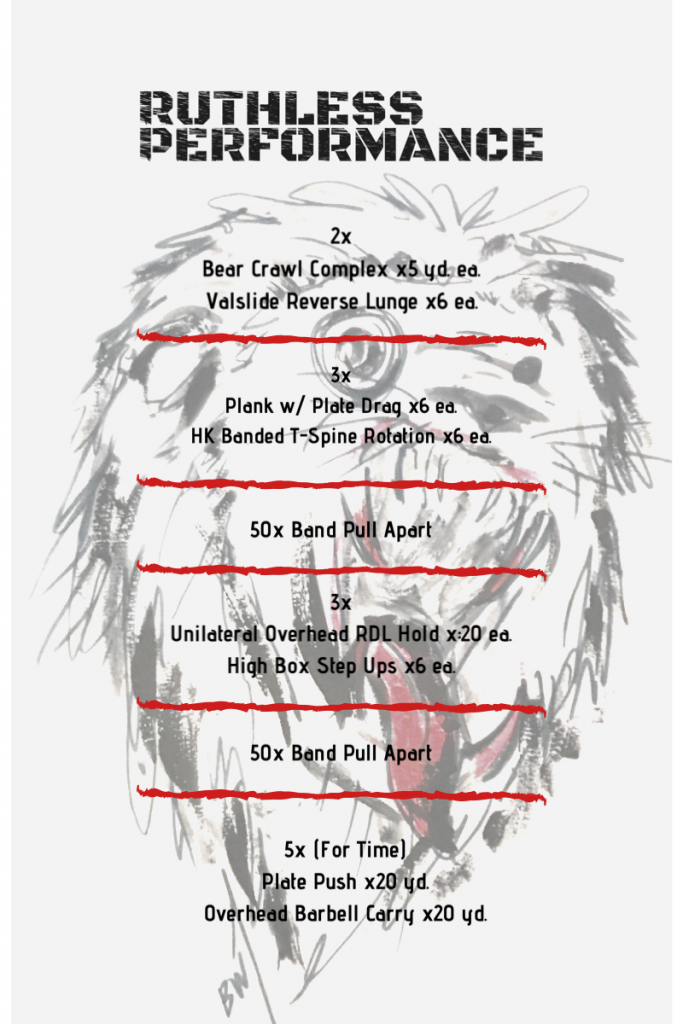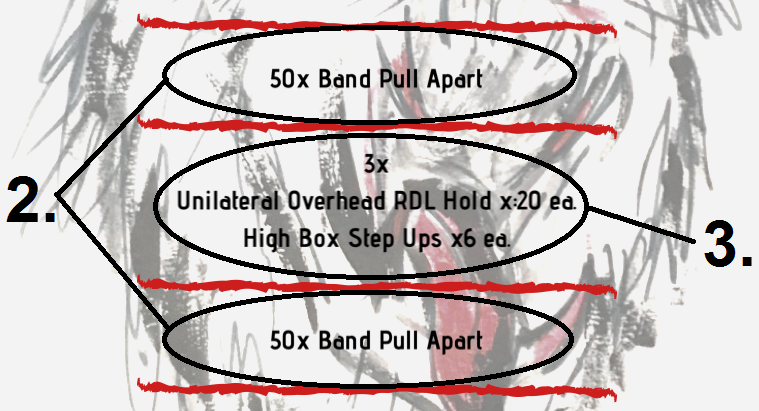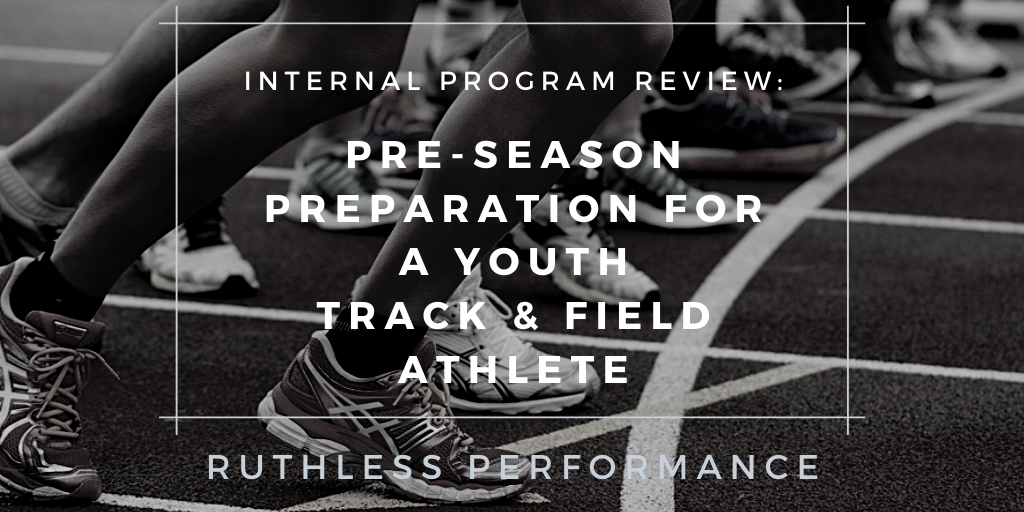
In this Internal Program Review installment, we’ll be covering a single pre-season workout for a youth track and cross country athlete. Though this is for a female, in the pre-high school training phases, sex matters very little in training style; but as these athletes develop more and more, the training requirements begin to diverge.
Athletes below the high school level are a rare find among the Ruthless Performance athlete roster. You’ll notice right away that this bares very little resemblance to our traditional Microsoft Excel-based training monitoring and data acquisition systems.
One of the many reasons for this is the non-linear training style we apply at this age. The younger an athlete is the more he or she will need a wide variety of training stimuli in their movement and exercise portfolio.
With this in mind, the exercise selection for this athlete changes almost daily. Some of the exercises which we find have the best response rate can stay for multiple workouts, while others are cycled through routinely, and even others can be a one-off occurrence.
The most basic of strength & conditioning principles still apply. We are in a constant battle against bad posture, striving to fix physical deficits either caused by sports participation or from negative lifestyle and behavior-related adaptations.
It’s hard to say if this is a good example of our training with this athlete because it changes so much and so frequently. But we normally alternate workouts between more cardiovascular-dominant workouts and more strength-oriented workouts. Regardless, here are a few thoughts and observations from this particular day’s programming.
1. Enhancing Proprioception is a Critical Piece of Injury Prevention

Like most of our programming, this workout starts out with some intricate, full-body exercises to boost heart rate while checking a few other boxes. We are chiefly focused on improving proprioception for both the long-haul, as well as for the duration of the workout.
Proprioception, simply put, is the ability to move more concisely and with greater awareness through space. By adding such a complicated exercise so early on, each subsequent exercise will be performed with greater focus and greater technical precision; proprioception, largely through the activation of the vestibular system, is to thank for this.
As mentioned, enhancing proprioception does not just provide temporary benefits. Long-term proprioceptive development can help an athlete with their running economy, avoiding sports injury during unanticipated falls or clashes, and even enhance force production through enhanced neuromuscular efficiency.
The Bear Crawl Complex is a series of forward, backwards, and lateral bear crawls done for a set distance. In order to maximize benefits to proprioception, we are very critical and specific with regards to bear crawl technique (this is true across the board with our athletes when we coach this).
2. Band Pull Aparts Should Come as No Surprise
Though band pull aparts being in our exercise portfolio is no secret, what may come as a surprise is the extent to which the pull apart can actually help running performance.
Because of the role that the trapezius plays with regards to the spine, stronger traps can actually enhance the ability of the glutes to produce and transmit force from the hips. Greater force in hip extension means more force into the ground and a greater capacity for rapid locomotion.
Beyond sport specificity, all of the traditional sound bytes regarding the value of the traps and pull aparts apply here. Better cuff function, less back pain; healthier athletes make for more receptive athletes come training and game time.
Healthier athletes make for more receptive athletes come training and game time. Click To Tweet
3. The Posterior Chain is Everything in Track & Field
This is a fantastic exercise circuit and the value of these are genuinely hard to overstate. Healthy knees are synonymous with posterior chain strength. Likewise, faster running is synonymous with posterior chain strength.
If you took two similarly advanced track and field athletes with the same limited weight room experience, and split them, having one focus an extra hour on technique and traditional training methods, while the other focused for the same length of time specifically training the posterior chain, the weight training athlete would always come out on top.
This is not an affront to our idea of anti-specificity training, as the glutes and hams are crucial for both sports performance as well as for injury prevention.
The Unilateral Overhead RDL Hold is, as the name implies, just a hold. Imagine you’re doing a unilateral DB RDL. Stop with the hips bent, bring the arms straight overhead, and hold. This places a great deal of strain on the hamstrings and teaches the body to better absorb force and maintain tension in the posterior chain as a whole.
In conjunction with the Unilateral Overhead RDL Hold, the High Box Step Up does a great job at separating the hips and facilitates their independence and mobility. Our strategy for overloading the High Box Step Up, is a multi-pronged approach. We will continue to overload box height until we feel that adding more to the height will be of marginal benefit. From here, we begin to add load in either a goblet, suitcase, or farmers position. But ultimately the goal is the increased range of motion on the step up with a greater box.
By adding to the range we’re demanding by using a large box for step ups, the hamstrings are challenged to stretch under active load, then challenged to maintain tension in the RDL hold.
Though this is for a 13 year-old athlete, this is a truly effective, and strenuous, exercise circuit. Were it not for our ability to rapidly change our programming to accommodate the recovery and stress response rate of an athlete so young, we might have never been able to challenge her with so much success.
These two, when paired together can provide tremendous upside, even for someone with very little training. Just reduce the overall height of the box to a point where the athlete can demonstrate total control throughout the complete range of motion on the box. Progress the RDL hold by adding more time or a blinded component (have athletes close eyes).
4. Pre-Season Training Should be Conditioning-Intensive
The very nature of pre-season in a volume-based sport like track means that we need to get the athlete’s work capacity up and ready to go as soon as possible for the demands of in-season training. An athlete who goes into the season already conditioned can spend more time within the season adapting to the skills and technique associated with practice without having to first adapt to the fundamental cardiovascular demands of sport.
An athlete who goes into the season already conditioned can spend more time adapting to the skills and technique associated with practice without having to first adapt to the fundamental cardiovascular demands of sport. Click To Tweet
The conditioning set here might be somewhat unique, but I would recommend this for anyone looking to enhance their cardiorespiratory capacity.
The value of the plate push, as it relates to a young track athlete, is that the plate push helps develop some of the deeper hip musculature rarely developed in traditional S&C work. Much like we need balance between antagonistic muscles, we also need to strive for balance and develop out the end-ranges of a muscle’s capabilities. This forward position has equal value in reinforcing sprint mechanics, which can be lost out of season, particularly when the athlete’s secondary sport in cross-country. Nothing trains speed out of an athlete like unchecked, poor quality, long-distance runs.
Nothing trains speed out of an athlete like unchecked, poor quality, long-distance runs. Click To TweetThe overhead barbell carry serves to further develop this young athlete’s ability to move and perform the very vital pattern of loaded carries. The overhead position, when paired with the plate push, serves to inhibit the athletes ability to recover, and therefore provide a greater deal of strain to work through.
Because this is such a young athlete, we’re not even talking about a women’s olympic bar (35 lb.) for the overhead carries, rather we are using pre-set bars weighing between 8-12 lbs.
It’s Preseason for a Reason…
The preseason is the best time to address weakness, lay the groundwork for technique development, and build out an advanced cardiorespiratory system. When you’re trying to build new skills, you can’t concurrently build up your max heart rate, both will suffer and neither will improve. This is why you must keep cardio training as general as possible and only begin to transition into sport-specific work as the season progresses.


Pingback: Featured Fitness Content: Volume 52 (February) – Ruthless Performance